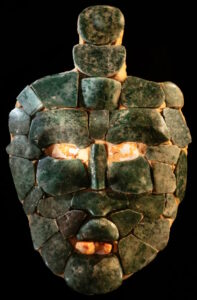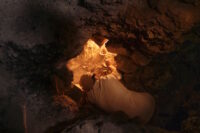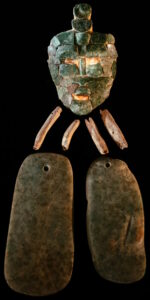 A magnificent jade face mask has been discovered in a Maya royal burial at the Chochkitam site near Petén, northeastern Guatemala. Dating to around 350 A.D., the mask is made of jade tesserae with spondylus shells for the mouth and eyes. Their translucent, flesh-toned qualities give the mask a vivid glow when backlit. It is believed to represent the Maya storm god.
A magnificent jade face mask has been discovered in a Maya royal burial at the Chochkitam site near Petén, northeastern Guatemala. Dating to around 350 A.D., the mask is made of jade tesserae with spondylus shells for the mouth and eyes. Their translucent, flesh-toned qualities give the mask a vivid glow when backlit. It is believed to represent the Maya storm god.
The burial chamber was found inside a pyramid structure in 2021. Obscured by the heavy canopy of the Petén rainforest, the Chochkitam site had not been thoroughly explored by archaeologists, but it was the target of looters who dug tunnels into the mounds seeking treasure. Researchers mapping the site with LIDAR technology spotted a burial chamber in the pyramid that the looter’s tunnels had failed to reach. They had to dig more than 20 feet into the pyramid before they encountered human remains — a skull, teeth — and a coffin-shaped stone box. The box contained offerings: a ceramic pot, large oyster shells, pieces of bone and pieces of jade that proved to be tesserae from a mosaic mask.
 That the burial chamber was contained inside a pyramid already indicated it belonged to a local king; the contents confirmed it. In addition to the mask, archaeologists found two large jade plaques, 13 spondylus shells and a stingray spine (a sharp reference to the king’s manhood).
That the burial chamber was contained inside a pyramid already indicated it belonged to a local king; the contents confirmed it. In addition to the mask, archaeologists found two large jade plaques, 13 spondylus shells and a stingray spine (a sharp reference to the king’s manhood).
The tesserae of the mask were transported to the Holmul Archaeological Project Laboratory in Antigua, Guatemala, where in June 2022, National Geographic Explorer, archaeologist and dig leader Francisco Estrada-Belli, puzzled it back together.
A sharp-eyed colleague noted that some of the bones the archaeologists had thought belonged to the crypt’s inhabitant were actually covered in fine carvings, likely made using volcanic obsidian glass. As it turned out, two of the bones weren’t those of the buried king at all—but their carvings revealed the identity of the royal ruler. Extraordinarily, one of the carvings depicted a ruler holding up the head of a Maya deity—the exact god represented in the mask Estrada-Belli had pieced together.
But who were they? University of Alabama archaeologist Alexandre Tokovinine, who specializes in Maya epigraphy, helped Estrada-Belli decode the glyphs, unlocking the secrets of the identities of both the ruler—Itzam Kokaj Bahlam (“sun god/bird/jaguar”)—and the god. Known to archaeologists as Yax Wayaab Chahk G1, the swirling deity represents a manifestation of the Maya storm god directly translated as “first sorcerer rain god.”
The find is “very, very unusual,” says Estrada-Belli—and has proven extraordinarily informative about a time and place that remain stubbornly obscure.
 Radiocarbon dating of the bones in the burial chamber returned a result of around 350 A.D., the early part of the Maya Classic period. Itzam Kokaj Bahlam was likely the ruler of the city, but there is evidence in the depictions of royalty elsewhere at the site that he was a vassal king, beholden to much more powerful dynastic rulers in Tikal and Teotihuacán. Compared to them, Chochkitam was a small, remote city with very limited power and range.
Radiocarbon dating of the bones in the burial chamber returned a result of around 350 A.D., the early part of the Maya Classic period. Itzam Kokaj Bahlam was likely the ruler of the city, but there is evidence in the depictions of royalty elsewhere at the site that he was a vassal king, beholden to much more powerful dynastic rulers in Tikal and Teotihuacán. Compared to them, Chochkitam was a small, remote city with very limited power and range.
There’s more to learn about the kings of Chochkitam and their connections to other powerful rulers in the still-murky early Classic period of the Maya. Estrada-Belli and his colleagues intend to pursue everything from ancient DNA studies of the bones found at the site to the possibility of finding more treasures buried within these abandoned pyramids.
The general area where it was found, is today, a big jade mining area, both legal and in the wind.
As it probably was in the past…